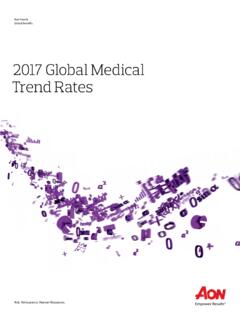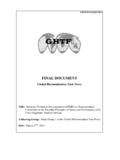Transcription of Rare Earth Elements: The Global Supply Chain
1 Rare Earth Elements: The Global Supply Chain Marc Humphries Specialist in Energy Policy December 16, 2013. congressional research Service 7-5700. R41347. CRS Report for Congress Prepared for Members and Committees of Congress Rare Earth Elements: The Global Supply Chain Summary The concentration of production of rare Earth elements (REEs) outside the United States raises the important issue of Supply vulnerability. REEs are used for new energy technologies and national security applications. Two key questions of interest to Congress are: (1) Is the United States vulnerable to Supply disruptions of REEs? (2) Are these elements essential to national security and economic well-being? There are 17 rare Earth elements (REEs), 15 within the chemical group called lanthanides, plus yttrium and scandium. The lanthanides consist of the following: lanthanum, cerium, praseodymium, neodymium, promethium, samarium, europium, gadolinium, terbium, dysprosium, holmium, erbium, thulium, ytterbium, and lutetium.
2 Rare earths are moderately abundant in the Earth 's crust, some even more abundant than copper, lead, gold, and platinum. While more abundant than many other minerals, REEs are not concentrated enough to make them easily exploitable economically. The United States was once self-reliant in domestically produced REEs, but over the past 15 years has become 100% reliant on imports, primarily from China, because of lower-cost operations. Molycorp has begun production at its Mountain Pass mine and anticipates production at full capacity (19,050 metric tons) in 2014. Molycorp also operates a separation plant at Mountain Pass, CA, and sells rare Earth concentrates and refined products from newly mined and previously mined above-ground stocks. Molycorp announced its purchase of Neo Materials Technology (renamed Moly Canada), a rare Earth processor and producer of permanent magnet powders which has facilities in China. Some of the major end uses for rare Earth elements include use in automotive catalytic converters, fluid cracking catalysts in petroleum refining, phosphors in color television and flat panel displays (cell phones, portable DVDs, and laptops), permanent magnets and rechargeable batteries for hybrid and electric vehicles, generators for wind turbines, and numerous medical devices.
3 There are important defense applications, such as jet fighter engines, missile guidance systems, antimissile defense, space-based satellites and communication systems. World demand for rare Earth elements was estimated at 136,000 tons per year, with Global production around 133,600 tons in 2010. The difference was covered by previously mined above- ground stocks. World demand is projected to rise to at least 160,000 tons annually by 2016. according to the Industrial Minerals Company of Australia. Some mine capacity at Mt. Weld Australia has come on-stream in 2012, but far below the projected 11,000 metric tons of capacity. Other new mining projects could easily take as long as 5-10 years to reach production. In the long run, however, the Geological Survey expects that Global reserves and undiscovered resources are large enough to meet demand. In March 2012, the Obama Administration announced the filing of a World Trade Organization case against China, citing unfair trade practices in rare earths.
4 A final decision is expected to be announced in early 2014. Several legislative proposals have been introduced in the 113th Congress in the House and Senate to address the potential of Supply vulnerability and to support domestic production of REEs and other critical minerals because of their applications for national security/defense systems and clean energy technologies. On September 18, 2013, the House passed 716, The National Strategic and Critical Minerals Production Act of 2013. congressional research Service Rare Earth Elements: The Global Supply Chain Contents 1. What Are Rare Earth Elements? .. 2. Major End Uses and Applications .. 2. Demand for Rare Earth Elements .. 3. Rare Earth Oxide Prices .. 5. The Application of Rare Earth Metals in National Defense .. 7. Rare Earth Resources and Production Potential .. 8. Supply Chain Issues .. 13. Molycorp's Mine to Magnet Vertical Integration Approach for Rebuilding the Rare Earth Supply 14.
5 Selected Recent Supply Chain Developments .. 16. Role of 16. Japan's Interests .. 19. Selected Possible Policy Options .. 20. research and Development .. 20. Authorize and Appropriate Funding for a USGS Assessment .. 20. Support and Encourage Greater Exploration for 20. Establish a 20. Hearings on Rare Earths and Related Legislation in the 113th Congress .. 21. Executive Branch 22. Department of Energy .. 22. Department of the Interior .. 22. Department of Defense .. 23. Other Federal Agencies .. 23. White House Office of Science and Technology 24. Figures Figure 1. Rare Earth Demand by and World, 2010 .. 5. Figure 2. Rare Earth Demand by and World, 2015 .. 5. Figure 3. Selected Rare Earth Oxide Prices, 2008-2013 .. 7. Figure 4. Rare Earth Elements: World Production, Reserves and Imports .. 11. Tables Table 1. Rare Earth Elements (Lanthanides): Selected End 3. Table 2. Rare Earth Elements: World Production and Reserves 2011.
6 10. Table 3. China's Rare Earth Production and Exports, 2006-2011 .. 19. congressional research Service Rare Earth Elements: The Global Supply Chain Appendixes Appendix. Rare Earth -Related Legislation in the 113th Congress .. 25. Contacts Author Contact 27. congressional research Service Rare Earth Elements: The Global Supply Chain Introduction The concentration of rare Earth elements (REEs) production in China raises the important issue of Supply vulnerability. REEs are used for many commercial applications including new energy technologies, electronic devices, automobiles, and national security applications. Is the vulnerable to Supply disruptions? Are these elements essential to national security and economic well-being? The examination of REEs for new energy technologies reveals a concentrated and complex Global Supply Chain and numerous end-use applications. Placing the REE Supply Chain in the Global context is unavoidable.
7 The current goal of mineral policy is to promote an adequate, stable, and reliable Supply of materials for national security, economic well-being, and industrial production. mineral policy emphasizes developing domestic supplies of critical materials and encourages the domestic private sector to produce and process those But some raw materials do not exist in economic quantities in the United States, and processing, manufacturing, and other downstream ventures in the United States may not be cost competitive with facilities in other regions of the world. However, there may be public policies enacted or executive branch measures taken to offset the disadvantage of its potentially higher cost operations. The private sector may achieve lower cost operations with technology breakthroughs. Based on this policy framework, Congress and the Administration are discussing the impact of China's near-monopoly position in rare Earth elements and a range of potential federal investments that would support the development of a vertically integrated rare Earth Supply Chain in the United States.
8 Aside from a small amount of recycling, the United States is 100% reliant on imports of REEs and highly dependent on many other minerals that support its economy. For example, the United States is more than 90% import-reliant for the following minerals: manganese (100%), bauxite (100%), platinum (94%), and uranium (90%). While import reliance may be a cause for concern, high import reliance is not necessarily the best measure, or even a good measure, of Supply risk. The Supply risk for bauxite, for example, may not be the same as that for REEs due to the multiplicity of potential sources. In the case of REEs, the dominance of China as a single or dominant supplier of the raw material, downstream oxides, associated metals and alloys, may be a cause for concern because of China's export restrictions and growing internal demand for its REEs. This report provides a discussion of the major issues and concerns of the Global Supply Chain for REEs, their major end uses, and legislative and other policy proposals that Congress may consider to improve the rare Earth position.
9 An Appendix section provides a summary of rare Earth -related legislation in the 113th Congress. 1. mineral policies provide a framework for the development of domestic metal mineral resources and for securing supplies from foreign sources. Specifically, the Mining and Minerals Policy Act of 1970 (30 21a) declared that it is in the national interest of the United States to foster the development of the domestic mining industry .. including the use of recycling and scrap. The National Materials and Minerals Policy, research and Development Act of 1980. (30 1601) declares, among other things, that it is the continuing policy of the United States to promote an adequate and stable Supply of materials necessary to maintain national security, economic well-being and industrial production, with appropriate attention to a long-term balance between resource production, energy use, a healthy environment, natural resources conservation, and social needs.
10 congressional research Service 1. Rare Earth Elements: The Global Supply Chain What Are Rare Earth Elements? There are 17 rare Earth elements (REEs), 15 within the chemical group called lanthanides, plus yttrium and scandium. The lanthanides consist of the following: lanthanum, cerium, praseodymium, neodymium, promethium, samarium, europium, gadolinium, terbium, dysprosium, holmium, erbium, thulium, ytterbium, and lutetium. Rare earths are moderately abundant in the Earth 's crust, some even more abundant than copper, lead, gold, and platinum. While some are more abundant than many other minerals, most REEs are not concentrated enough to make them easily exploitable The United States was once self-reliant in domestically produced REEs, but over the past 15 years has become 100% reliant on imports, primarily from China, because of lower-cost The lanthanides are often broken into two groups: light rare Earth elements (LREEs) lanthanum through europium (atomic numbers 57-63) and the heavier rare Earth elements (HREEs) gadolinium through lutetium (atomic numbers 64-71).













